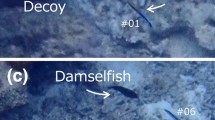Abstract
Gravid and barren Daphnia pulex were exposed to a variety of predators in laboratory aquaria. Small fish (guppies, sticklebacks and shiner fry) consistently preferred the gravid females, establishing the existence of a behavioural cost of reproduction. However, no such cost was associated with predation by more efficient visual predators (sunfish) or by nonvisual predators (hydras), and the excess of gravid females eaten by backswimmers was found to be attributable to their distribution in the water column. Moreover, the cost associated with predation by small fish was observed only when the Daphnia were presented against a light background, and was abolished when a dark background was substituted. In a further series of experiments with guppies we attempted to show that each egg added to the brood caused a decrease in survival; in two such experiments survival rate was related to body size but not to fecundity, while in a third the effect of body size did not appear, and a negative correlation between survival and fecundity could be demonstrated. Although these experiments unambiguously demonstrate a cost of reproduction they also illustrate the elusiveness of the phenomenom and emphasize the need to develop theories which specify the type and magnitude of costs generated by different ways of life.
Similar content being viewed by others
References
Bell G (1983) Measuring the cost of reproduction. III. The correlation structure of the early life history of Daphnia pulex. Oecologia (Berl) 60:378–383
Bell G (1984a) Measuring the cost of reproduction. I. The correlation structure of the life table of a plankton rotifer. Evolution 38:300–313
Bell G (1984b) Measuring the cost of reproduction. II. The correlation structure of the life tables of five freshwater invertebrates. Evolution 38:314–326
Dean JM (1981) The relationship between lifespan and reproduction in the grasshopper Melanoplus. Oecologia (Berl) 48:385–388
Green J (1956) Growth, size and reproduction in Daphnia (Crustacea: Cladocera). Proc Zool Soc Lond 126:173–205
Haas R (1976) Sexual selection in Notobranchius guentheri (Pisces: Cyprinodontidae). Evolution 30:614–622
Partridge L, Farquhar M (1981) Sexual activity reduces lifespan of male fruitflies. Nature 294:580–582
Rose MR, Charlesworth B (1981) Genetics of life history in Drosophila melanogaster. I. Sib analysis of adult females. Genetics 97:173–186
Semler DE (1971) Some aspects of adaptation in a polymorphism for breeding colors in the threespine stickleback (Gasterosteus aculeatus). J Zool (Lond) 165:291–302
Shine R (1980) “Costs” of reproduction in reptiles. Oecologia (Berl) 46:92–100
Snell TW, King CE (1977) Lifespan and fecundity patterns in rotifers: the cost of reproduction. Evolution 31:882–890
Tallamy DW, Denno RF (1982) Life-history trade-offs in Gargaphia solani (Hemiptera: Tingidae): The cost of reproduction. Ecology 63:616–620
Williams GC (1966) Natural selection, the costs of reproduction, and a refinement of Lack's principle. Am Natur 100:687–690
Author information
Authors and Affiliations
Rights and permissions
About this article
Cite this article
Koufopanou, V., Bell, G. Measuring the cost of reproduction. Oecologia 64, 81–86 (1984). https://doi.org/10.1007/BF00377548
Received:
Issue Date:
DOI: https://doi.org/10.1007/BF00377548




